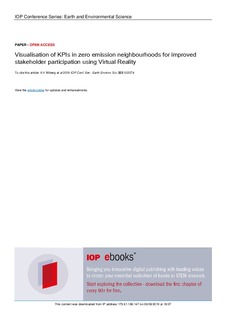| dc.contributor.author | Houlihan Wiberg, Aoife Anne Marie | |
| dc.contributor.author | Løvhaug, Solveig | |
| dc.contributor.author | Mathisen, M | |
| dc.contributor.author | Tschoerner, B | |
| dc.contributor.author | Resch, Eirik | |
| dc.contributor.author | Erdt, Mojisola Helen | |
| dc.contributor.author | Prasolova-Førland, Ekaterina | |
| dc.date.accessioned | 2019-11-19T08:50:07Z | |
| dc.date.available | 2019-11-19T08:50:07Z | |
| dc.date.created | 2019-11-04T14:12:33Z | |
| dc.date.issued | 2019 | |
| dc.identifier.citation | IOP Conference Series: Earth and Environmental Science (EES). 2019, 323 (1), 1-10. | nb_NO |
| dc.identifier.issn | 1755-1307 | |
| dc.identifier.uri | http://hdl.handle.net/11250/2629188 | |
| dc.description.abstract | This paper addresses the role of virtual reality in addressing the specific challenge of the increasing complexity and decreasing usability when dealing with the level of detail required to model a zero emission neighbourhood (ZEN).[1] In such neighbourhoods, there is a need to handle both 'top down' neighbourhood level data with 'bottom up' building and material level data. This can quickly become overwhelming particularly when dealing with non expert users such as planners, architects, researchers and citizens who play a key part in the design process of future ZENs. Visualisation is an invaluable means to communicate complex data in an interactive way that makes it easier for diverse stakeholders to engage in decision making early and throughout the design process. The main purpose of this work has been to make ZEN key performance indicators (KPIs) more easily comprehensible to a diverse set of stakeholders who need to be involved in the early design phase. The paper investigates how existing extended reality (XR) technologies, such as virtual reality, can be integrated with an existing dynamic LCA method in order to provide visualise feedback on KPIs in early phase design of sustainable neighbourhoods. This existing method provides a dynamic link between the REVIT Bim and the ZEB Tool using a Dynamo plugin.[2] The results presented in this paper demonstrate how virtual reality can help to improve stakeholder participation in the early design phase and more easily integrate science-based knowledge on GHG emissions and other KPIs into the further development of the user-centered architectural and urban ZEN toolbox for the design and planning, operation and monitoring of ZENs. [3] | nb_NO |
| dc.language.iso | eng | nb_NO |
| dc.publisher | IOP Publishing | nb_NO |
| dc.rights | Navngivelse 4.0 Internasjonal | * |
| dc.rights.uri | http://creativecommons.org/licenses/by/4.0/deed.no | * |
| dc.title | Visualisation of KPIs in zero emission neighbourhoods for improved stakeholder participation using Virtual Reality | nb_NO |
| dc.type | Journal article | nb_NO |
| dc.type | Peer reviewed | nb_NO |
| dc.description.version | publishedVersion | nb_NO |
| dc.source.pagenumber | 1-10 | nb_NO |
| dc.source.volume | 323 | nb_NO |
| dc.source.journal | IOP Conference Series: Earth and Environmental Science (EES) | nb_NO |
| dc.source.issue | 1 | nb_NO |
| dc.identifier.doi | 10.1088/1755-1315/323/1/012074 | |
| dc.identifier.cristin | 1743886 | |
| dc.relation.project | Norges forskningsråd: 257660 | nb_NO |
| dc.description.localcode | Content from this work may be used under the terms of theCreative Commons Attribution 3.0 licence. Any further distribution of this work must maintain attribution to the author(s) and the title of the work, journal citation and DOI. Published under licence by IOP Publishing Ltd | nb_NO |
| cristin.unitcode | 194,61,55,0 | |
| cristin.unitcode | 194,0,0,0 | |
| cristin.unitcode | 194,67,70,0 | |
| cristin.unitname | Institutt for arkitektur og teknologi | |
| cristin.unitname | Norges teknisk-naturvitenskapelige universitet | |
| cristin.unitname | Institutt for pedagogikk og livslang læring | |
| cristin.ispublished | true | |
| cristin.fulltext | original | |
| cristin.qualitycode | 1 | |

